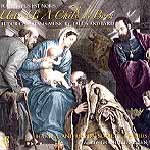Boston’s Handel & Haydn Society, founded nearly 200 years ago and responsible for the American premieres of such works as Handel’s Messiah, makes some lovely sound here, a sign that these singers have been well chosen for vocal beauty and technical facility. However, these qualities don’t prove enough in themselves to make fully convincing performances of the William Byrd selections on offer here. While accurate of note and intonation, and faithful to the letter of the score, the singers’ deliberate, un-nuanced, almost languid phrasing fails to impress us with the kind of ensemble mastery of these works we expect–and get–from specialist groups such as the Tallis Scholars or from choirs more familiar with this repertoire, like the Christ Church Cathedral Choir. It would be going too far to suggest that this very competent choir was under-rehearsed for these performances, but there’s nevertheless a feeling as the lines steadily stream along that these singers haven’t lived with the music very long and are just depending on their artistic instincts to make a respectable presentation–not that there’s anything really wrong with that. It’s just that this music can blossom so much more fully and fantastically–and a comparison with the reference versions will show how this happens. Part of the problem may be conductor Grant Llewellyn’s slow tempos, which are fine for indulging in Byrd’s inherent sonic riches but can be a challenge even for good singers to sustain essential linear tension necessary for a cohesive, multilayered musical structure.
The routineness of the Byrd is offset by more vibrant and dynamic performances of the Tallis selections–and it’s good to have another performance of the reconstructed Missa Puer natus est nobis available. The choir revels in Tallis’ big blocks of sound and even though again the tempos are slow, Llewellyn manages to build effective climaxes and keep his singers energized. Still, I prefer the brighter, more assured and uniformly solid interpretation by the Tallis Scholars. The recording here was made in one of North America’s finest vocal music venues, the Sonic Temple in Roslindale, Massachusetts, and it complements both music and voices with ideal bass-to-soprano balances and resonant, natural vocal timbres.
































